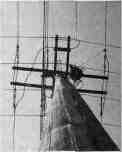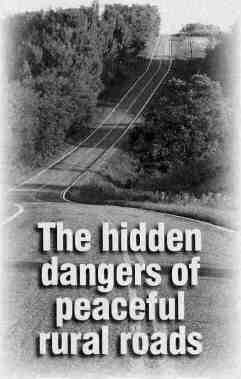
Touchstone Energy cooperatives continue to set the benchmark for energy industry service, obtaining a high score of 82 for customer satisfaction in a first quarter 2003 survey by the American Customer Satisfaction Index (ACSI). The score is nine points higher than the electric utility industry average of 73, with only one other utility scoring as high as Touchstone Energy co-ops.
"The fact that we're locally owned, responsive to our member-owners and committed to providing quality service continues to pay off in customer satisfaction," said Touchstone Energy Cooperatives Chief Operating Officer Jim Bausell. "This latest ACSI score is evidence that Touchstone Energy cooperatives are building strong customer loyalty through their first-rate service," he said.
ACSI is one of the most recognized customer satisfaction indices in the United States. It's managed by the University of Michigan Business School and sponsored by the American Society for Quality. It measures customers' satisfaction in 16 major industries and 190 leading corporations. The index is a weighted average of three questions on a 0 to 100 scale.
The results of the recent ACSI survey confirm that Touchstone Energy co-ops consistently
provide superior service in the electricity market. This is the second time in less than a year Touchstone Energy cooperatives have outdone their industry counterparts. The co-ops also received a high score of 82 in a second quarter 2002 survey.
Touchstone Energy is a national alliance of local, consumer-owned electric cooperatives providing high standards of service to customers large and small. More than 600 Touchstone Energy cooperatives in 44 states are delivering energy and energy solutions to approximately 17 million customers every day. Touchstone Energy cooperatives serve their members with integrity, accountability, innovation and a longstanding commitment to communities.
6 ILLINOIS COUNTRY LIVING www.icl.coop
Internet - an important resource for rural communities
While use of the Internet has increased in Illinois, many small rural communities are still waiting for reliable high-speed access. In fact, 81.7 percent of household users and 74.2 percent of small business users reported still using a dial-up connection, based on a report recently released by the Illinois Institute for Rural Affairs (IIRA) at Western Illinois University.
The report, written by Sharon Schumaker at the Southern Illinois University-Carbondale Office of Economic and Regional Development, discovered that rural Illinois households reported being online an average of 13.7 hours per week, with nearly all respondents reporting that they used the Internet for e-mail, 81 percent for searching the Internet for fun, and 79 percent for playing games online. Few household users reported using the Internet to earn income.
Small businesses in Illinois reported using the Internet an average of 13.4 hours per week. They use the Internet primarily for e-mailing vendors and customers, and purchasing supplies and equipment. A few reported selling online.
"The Internet has the potential to reduce the disadvantages of distance and smaller market size and to level the competitive playing field between urban and rural businesses," said Norman Walzer, IIRA director. "Because of their sparse population, rural areas have relatively higher costs for building a high-speed infrastructure. Lines must be laid over longer distances with fewer customers paying for them. At the same time, a lack of access to high-speed Internet service may be a factor in aggravating already weak rural economies."
The report also outlined the factors affecting adoption of high-speed technology, including costs and perceived need for the service. Several resources that exist for rural communities seeking to enhance their access to high-speed Internet service are summarized in the report.
Source: Darcie Shinberger, (800) 526-9943, www.iira.org.
Plant the right tree in the right place
Planting trees can improve your property value, save energy and help improve the environment. But the wrong type of tree in the utility right of way can lead to blinking lights, outages, and a dangerous situation for children who might climb in the trees.
Trees properly placed can lower line clearance costs for electric co-ops, reduce tree mortality, and result in healthier community forests.
Tall trees surrounding your home, such as maple, oak, pine and spruce, provide summer shade to lower cooling costs and keep out cold winter winds.
Medium trees, 40 feet or less in mature height, might include Washington hawthorne and Golden raintree, while smaller trees suitable for planting beneath utility lines might include Redbud, Dogwood and Crabapple. When planting near utility lines, consider a 25-foot maximum mature height and 20-foot spread.
Call your local electric cooperative or go to www.arborday.org for more information.
Power line Internet has potential for rural areas

Consumers could soon receive high-speed Internet through their electrical outlets — although the Internet won't be widely delivered over power lines for five to 10 years.
"Several electric utilities throughout the United states are conducting trials to test whether electric power lines could one day be an inexpensive 'third pipe' of broadband Internet access to the home, following cable modem and digital-subscriber line service," said Steve Collier, vice president of emerging technologies at the National Rural Telecommunications Cooperative (NRTC).
Trials include two conducted by Current Technologies in the Washington, D.C. suburbs and in Cincinnati. Another trial at Cullman Electric Cooperative in Alabama by PowerComm Systems, aka International Broadband Electric Communications (IBEC), appears to have a technology that works, according to Collier.
The concept of power line Internet technology has been around for a while. But, in the beginning, line interference from a variety of sources severely limited the flow of data causing initial efforts to fail. According to industry suppliers, those concerns have now been resolved.
Since their frequencies do not interfere with each other, electricity and high-frequency signals carrying Internet traffic can travel on the same lines.
Current Technologies uses a fiber optic "bridge" or a wireless transceiver, allowing the Internet signal to bypass the transformers that lower electrical voltage inside the house.
Current Technologies' recent demonstration of its technology to Federal Communications Commission Chair Michael K. Powell reportedly achieved transmission speeds four times as fast as cable modem or digital subscriber line Internet service.
Currently, about 80 percent of Americans have at least one high-speed Internet option. Since nearly all homes are wired for electricity, however, high-speed Internet could become even more widely available if broadband power line actually fulfills its promise.
Source: NRTC; Washington Post; CNN.com
AUGUST 2003 www.aiec.coop 7
Pet proofing your home
Millions of American homes have pets. And like children, your pets are at risk for getting hurt around electrical appliances.
Here are some tips for pet-proofing your homes against electrical accidents.
• Don't let your pets chew on electrical cords. Keep your pet with you when you're at home; when you're away or busy, confine your pet or use a baby gate to help keep them away from electrical hazards.
• Keep halogen lamps away from play areas for pets and children. Some halogen bulbs can reach temperatures of 1,000 degrees and could easily cause a nasty burn or fire.
• When you're finished with a small appliance, put it away. The pet could play with the cord and pull the appliance off the counter or bite through the insulation.
• Keep appliances away from sinks, bathtubs and pools. A pet could knock radios, curling irons and other items into the water, causing electrocution.
• Don't leave your pet unsupervised in a room with a space heater or lit candles. The pet could knock it over, or simply get too close and singe its fur!
• Don't let your pet sleep on an electric blanket. It could break the insulation in the wires, causing shocks and burns.
• Keep your dog on a leash when outside. It will keep your dog safe from traffic, and you can prevent it from getting too close to substations and downed power lines, which could cause electrocution.
• Cats are better off inside. If your cat is inside, it can't climb a power pole and risk electrocution on a transformer or power line. The same common sense precautions that keep you and your family safe around electricity will also help protect your pets.
Source: National Electrical Safety Foundation, Leviton Manufacturing Co., Inc.

Installing a setback thermostat
A programmable thermostat is one of the most reliable energy-savers available and could save as much as 10 to 15 percent on heating and cooling costs. They work by adjusting your home's temperature automatically to save energy when your family is sleeping or away from home.
Any thermostat is simply an automatic on-off switch for your heating or cooling system. During the heating season, when your home's temperature dips a degree or two, the thermostat turns the furnace on. After the temperature rises to the desired level, the thermostat turns the furnace off. The lower the temperature setting on the thermostat, the less energy your furnace consumes to heat the house. In hot weather, the thermostat turns your cooling system on when the temperature in your home rises beyond your chosen comfort level.
Programmable thermostats have a built-in clock that directs your heating or cooling system to turn on and off at specified times. A programmable thermostat can turn itself down 5 or 10 degrees before bedtime and back up to a comfortable temperature in the morning. The reduced thermostat setting reduces the operating time of your heating or cooling system, saving you money. If your home is empty during the day, the programmable thermostat turns itself down after you leave for work and returns the temperature to normal before you return.
Programmable thermostats cost $100 to $200 installed, saving far more than that in energy costs. If you use a heat pump, talk to your dealer or electric co-op representative about setback thermostats for heat pumps.
Source: Saturn Resource Management (www.residential-energy.com)

How to combat rising gas prices
Finding a job closer to home. Cruise Control. Coasting down the hill. These are all ways consumers around the nation say they are dealing with rising gasoline prices. As the nation's prices near 1991 Desert Storm levels, with no end in sight, consumers are looking for ways to cut costs. After all, according to the Bureau of Labor and Statistics, transportation costs account for 19 percent of total household costs, second only to housing. So rising gas prices can make a real dent in your budget if, like most Americans, your main mode of transport is your automobile.
Fuel saving experts recommend the following tips to save gas:
• Avoid high speeds.
• Do not accelerate or brake hard.
• Keep tires properly inflated
• Keep windows closed.
• Service vehicle regularly.
• Use cruise control.
• Avoid heavy loads.
• Avoid long idles.
• Purchase a fuel-efficient
vehicle.
Now, Web sites can help consumers save money too. For information on where you can buy the cheapest gas in your area, go to www.gaspricewatch.com and www.gasbuddy.com.
Source: U.S. Energy Information Agency; Department of Labor and Statistics; Tullahoma News; San Francisco Chronicle
8 ILLINOIS COUNTRY LIVING www.icl.coop

This time of year Illinois is made up of rolling hills, flat prairies, thousands of acres of ripe, green fields and a myriad of wildlife. And through all of this runs a collection of narrow dirt, gravel or broken paved roads.
Although driving in rural areas may seem more peaceful, it can be much more hazardous than driving in the city. Driving through the countryside, we escape red lights, traffic jams, road-raged drivers and road construction. But we also gain some additional hazards you may not have thought of. Here are some reminders to keep you safe as you enjoy the beautiful scenery along a country road:

Hopefully, the rural areas you drive through have green crops thriving in the fields. But as the corn grows taller, it becomes harder to see wildlife and other drivers.
Deer can break away suddenly out of a field, a tractor can pull out of an unmarked field entrance, or cars can be visually hidden at intersections. Since many rural intersections are unmarked, and without stop or yield signs, they are hazardous any time of year. But when the crops around them stand tall, it becomes virtually impossible to see who or what is coming.
If you're unfamiliar with a road, be sure to drive slowly so you have more time to stop when you encounter an intersection or field entrance.
Some drivers try the trick of turning off their headlights at night when approaching an intersection, or rolling down their windows to listen for cars. However, someone else may be using this approach also. They may have turned out their
lights, or may be paused at the intersection before crossing, making little noise. It's always safer to come to a complete stop at all intersections.

Be on the lookout for slow moving vehicles. Whether it's grandma going to church on Sunday, or a combine traveling from field to field, you need to be able to slow down quickly. Even with seat belt and air bag in place, the chances of surviving a crash with a fixed or heavy slow moving object are not good. School buses also make frequent stops and may be moving slowly.
Corners and hills can be especially treacherous. They can hide big augers and grain wagons, and cars that have drifted into the center of the road.
Be sure to share the road with other drivers. Many country roads are narrow and require passing drivers to slow down and each move onto the shoulder to pass.
And, keep an eye out for 4-wheelers and kids on bikes or go-carts. Many of these vehicles are not street-legal, and an inexperienced driver can get careless.

Rain can pool alongside or over the road. If the water is more than six inches deep across your path, take an alternate route. If it is lower than this, proceed through it slowly, but don't stop. Also, be aware that currents of water traveling over the road can be deadly, sweeping a car off the pavement and carrying it downstream, into a field, ditch, creek or river.

Railroad crossings can be equally dangerous. Hopefully all railroad crossings will be marked with at least the
standard white RR crossing sign, which are often worn and hard to see. Turn off your radio to listen for train whistles when you know you are approaching a crossing. Stop at all railroad crossings and look both ways to check for trains. Never try to cross before a train, even one that appears to be moving slowly.

If roads are foggy, use your low beams or fog lights. Use windshield wipers and defrost to keep your windshield clear. Slow down, but don't stop when entering heavy fog. Watch for slower vehicles ahead and listen for traffic you may not be able to see. On a foggy night in the countryside, it can be pretty spooky with no radio on, but leave it off to listen for other cars. The rate of accidents almost triples at night or in heavy fog on rural roads.
Follow these precautions and you'll be able to enjoy the countryside incident-free for years to come.
AUGUST 2003 www.aiec.coop 9

